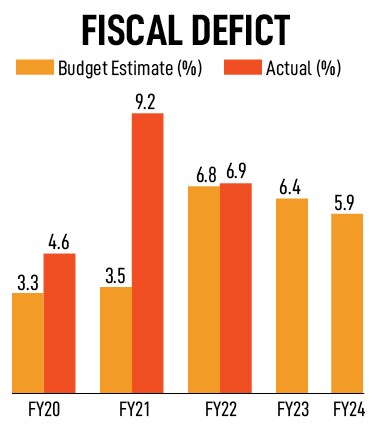The 'Goldilocks' budget for growth
In a masterful stroke, Finance Minister Nirmala Sitharaman has managed to walk the fiscal tightrope without faltering on fiscal targets despite an uptick in capital expenditure and social reforms


It is not uncommon for corporates to sugar coat their angst over disappointing Budget announcements. When corporates hail the finance minister for delivering a ‘super’ Budget, one takes it with a pinch of salt, as the tone isn’t hard to miss. But Budget 2023 is different. The mood is clearly upbeat.
Nilesh Shah, managing director, Kotak Mahindra AMC, says the Budget numbers are realistic, conservative and credible. “This Budget is a Baahubali budget. With one arrow, multiple targets are shot. Fiscal prudence is achieved with lower deficit and the path is set till FY26. Consumption is supported through tax cuts and the investment outlay has been enhanced," he adds.
The BJP government—in its last full year Budget—checked all the boxes with measures and incentives to boost investments and consumption, without straying from its fiscal consolidation path, to fast-track economic growth. The government retained its FY23 fiscal deficit target of 6.4 percent and expects it to narrow to 5.9 percent in FY24, and eventually meet its goal of lowering it to 4.5 percent in FY26.
“Overall, this Budget’s push on capex will ensure that the private capex green shoots really sustain, help inclusive growth, and make the economy become more resilient in light of the global slowdown. Both equity and bond markets have reacted positively to the Budget, as the thrust to maintain the cyclical recovery and largely maintain fiscal prudence has helped lift sentiments," says Chirag Mehta, CIO, Quantum AMC.
The S&P BSE Sensex ended the trading session 158 points higher at 59,708 and the bond market closed 0.9 percent lower at 7.27.
The government has been very articulate in its desire for an investment-led phase of growth to create jobs in the world’s most populous country. In line with this objective, for the third consecutive year, the government announced ambitious capex plans for building infrastructure which it hopes will trigger a multiplier effect to boost growth and development in the economy where investment and consumption have been in low gear.
“Despite the increased capex spending, the fiscal deficit target has been reduced from 6.4 percent in FY23 to 5.9 percent in FY24, and as a result, the market borrowing figure was also below estimates. This has helped the fixed income markets with bond yields falling significantly post the Budget announcement," says Sampath Reddy, chief investment officer, Bajaj Allianz Life.
 To address this, this year, Finance Minister Nirmala Sitharaman announced a sharp increase of 33 percent in capital expenditure to Rs10 lakh crore. In addition, the outlay for railways is at its highest of Rs2.4 lakh crore. Effectively, the government’s total outlay for capital investment is equal to 4.5 percent of the GDP.
To address this, this year, Finance Minister Nirmala Sitharaman announced a sharp increase of 33 percent in capital expenditure to Rs10 lakh crore. In addition, the outlay for railways is at its highest of Rs2.4 lakh crore. Effectively, the government’s total outlay for capital investment is equal to 4.5 percent of the GDP.
This sparked excitement in markets. Also, the reduction in tax slabs under the new tax regime brought relief for the middle class, and can be a trigger for higher spending in the coming months. “The tax benefits have been tweaked to encourage individuals to move towards the new tax regime, and to provide relief to the middle class and to the highest income strata. While the government is foregoing effective revenue of Rs350 billion, this could have a consumption multiplier effect, albeit at the margin, in the economy that’s seeing fading consumption growth," says Emkay Global Financial Services’ lead economist Madhavi Arora.
“The Union Budget has a dual focus on growth and fiscal consolidation. The fiscal calculation is based on a nominal GDP growth projection of 10.5 percent which is credible. At the same time, the fiscal deficit target of 5.9 percent is largely in line with our estimates while the borrowing amount is slightly below our expectations," highlights Mahesh Patil, CIO, Aditya Birla Sun Life Mutual Fund.
While the fiscal roadmap for FY23 and FY24 is on anticipated lines, the target of 4.5 percent for FY26 is challenging. Given the many moving parts, such as the pace of global economic recovery and geopolitical concerns, it is hard to predict to what extent this is realistic. Of course, the government is pinning its hopes on rapid and sustainable domestic growth to meet its lofty targets amid ambitious capex and populist social reforms.
First Published: Feb 01, 2023, 16:29
Subscribe Now